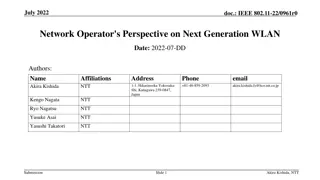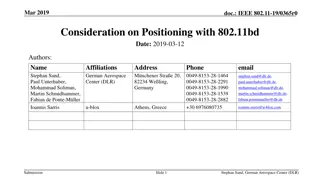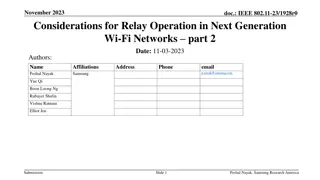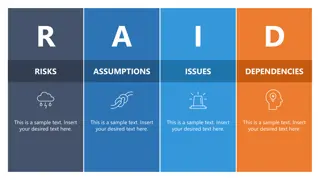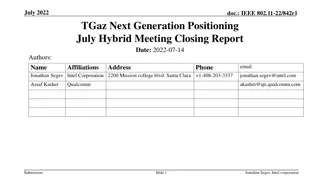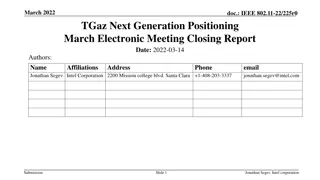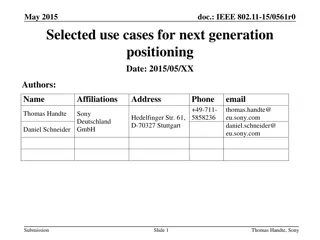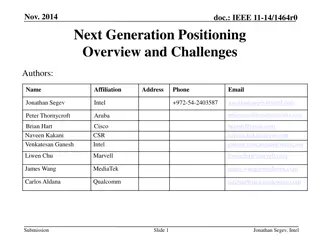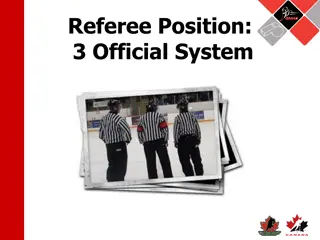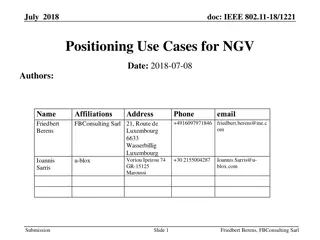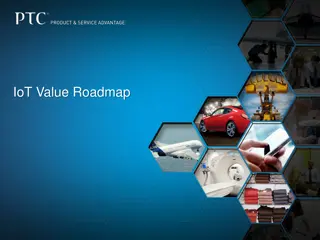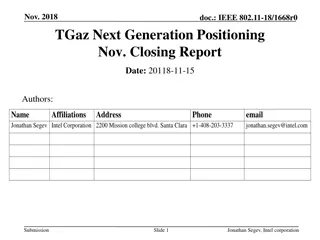Proposed Use Cases Template for Next Generation Positioning
This document presents a proposed template for describing use cases and location requirements for Next Generation Positioning technology. It includes detailed information on user tasks, environment specifications, key location requirements, expected accuracy, latency, refresh rate, and simultaneous users. The goal is to provide a comprehensive framework for incorporating diverse use cases and driving focus for the study group.
Download Presentation

Please find below an Image/Link to download the presentation.
The content on the website is provided AS IS for your information and personal use only. It may not be sold, licensed, or shared on other websites without obtaining consent from the author. Download presentation by click this link. If you encounter any issues during the download, it is possible that the publisher has removed the file from their server.
E N D
Presentation Transcript
Mar 2016 doc.: IEEE 802.11-16/0137r4 NGP Use Case Template Date: 2016-03-12 Authors: Name Santosh Pandey Affiliations Address Cisco Systems Phone +1-408-8535990 email sanpande@cisco.com brianh@cisco.com Brian Hart Cisco Systems ChaoChun Wang MediaTek Revision 0: Merging 11-15-0388r2 and 11-16-0019r0 Revision 1: Adding use case 18 Submission Slide 1 Santosh Pandey, Cisco
Mar 2016 doc.: IEEE 802.11-16/0137r4 Abstract This document is a proposed template to describe use cases, and some location requirements per use case, for Next Generation Positioning In this initial version, only one sample use case is included. Additional use cases are expected to be added in future versions of this document Location requirements are included with each use case to drive focus for the study group The goal is to come up with a superset of everything potentially needed and then narrow down the field from there on Submission Slide 2 Santosh Pandey, Cisco
Mar 2016 doc.: IEEE 802.11-16/0137r4 Terminology User The end entity (human) who would use this technology Use case A use case is task oriented. It describes the specific step by step actions performed by a user or device. One use case example is a user starting and stopping a video stream. Environment The type of place in which a network is deployed, such as home, outdoor, hot spot, enterprise, metropolitan area, etc. Frequency bands of interest (FBoI): The 802.11 operating frequency bands relevant to this use case. Eg. for a shopping mall s enterprise wireless it will be 2.4GHz and 5GHz AP density: Density of AP deployment, e.g. APs deployed every 4000 sq.ft. AP height: Height, above the floor, at which the APs are deployed, e.g. for shopping mall APs deployed approximately 15-25 ft above the floor Key Location Requirement- Expected Horizontal Accuracy: XY accuracy expected for the use case to succeed, <1m@90% is a requirement is that the computed location be within 1m horizontally of the actual location 90% of the time Expected Vertical Accuracy: Z accuracy expected for the use case to succeed, same floor@99% is a requirement is that the computed location be on the same floor as the actual location 99% of the time. 0.5m@90% is a requirement is that the computed location be within 0.5m vertically of the actual location 90% of the time Expected Latency: Expected time taken to complete a single atomic location process. The location process begins with initiating a location request, then computing location, and ends with returning the computed location. E.g. 10 ms latency would indicate that it takes 10 ms after the request is transmitted to gather measurements, compute a location, and transfer any parameters such that the requester has a location within 10 ms. Expected Refresh Rate: This defines how frequently is the computation expected when client moving. E.g. a refresh rate of 10 locations per second would indicate that location needs to be refreshed 10 times in a second Expected number of simultaneous users Submission Slide 3 Santosh Pandey, Cisco
Mar 2016 doc.: IEEE 802.11-16/0137r4 1. Micro location in store User: Person with a smartphone which has the store app installed Environment: A store has APs for 802.11 coverage. The store may have APs at the store entrance. The expected AP density is about 1 AP per 4000 sq. ft. with APs supporting HT, VHT and NGP Use case: 1. The user enters the store with their phone 2. As soon as user enters, the phone notifies the user about the store promotions 3. The user can query details about a product on the app 4. The app and smartphone can then help the user navigate to the particular shelf containing the product 5. The user stands in queue and as they reaches the checkout counter, their loyalty number is brought up on the system Expected: Horizontal accuracy: <0.5 m@90%, vertical accuracy: same floor@99% Latency: <500ms Refresh Rate: > 1 location/sec Submission Slide 4 Santosh Pandey, Cisco
Mar 2016 doc.: IEEE 802.11-16/0137r4 2. Positioning for Home Audio Background: Advanced audio formats with immersive sound experience require exact position estimates of listener and speakers User: Person with WLAN based home audio system WLAN is employed for both sound transfer and positioning Environment: Smart home with 802.11 coverage. 1 AP per floor supporting .11n, .11ac, and NGP 1 AP in close vicinity supporting .11ad, .11ay, and NGP Optional: multiple APs from neighboring apartments Use case speaker system calibration 1. The user installs his home audio system including various WLAN speakers 2. The speaker placement and position is automatically determined 3. The home audio system adjusts the speaker settings for best sound experience Use case follow-me sound 1. The user has a wearable WLAN device 2. The device s position is continuously monitored 3. The home audio system adjusts the speaker settings according to the user s position and movement for immersive sound experience 4. In a simple case, the sound may only follow in neighboring rooms A. B. Submission Slide 5 Thomas Handte, Sony
Mar 2016 doc.: IEEE 802.11-16/0137r4 2. Positioning for Home Audio (cont.) Positioning requirements Use case speaker system calibration follow-me sound same room @ 99% (simple) Horizontal accuracy < 10cm @ 90% < 50cm @ 90% (typ.) < 10cm @ 90% (high fidelity) 1 same floor @ 99% (simple) not required < 50cm @ 90% (typ.) 1 Vertical accuracy < 10cm @ 90% (high fidelity) < 10cm @ 90% (high fidelity) 1 Latency < 10ms < 10ms > 2 > 10 locations/s (depending on accuracy) Refresh rate < 0.1 locations/s Exp. number of simultaneous users 1 <= 5 The user may accept further APs for high fidelity 1) orientation between wearable device and ear must be known (e.g. smart eyeglasses) Submission Slide 6 Thomas Handte, Sony
Mar 2016 doc.: IEEE 802.11-16/0137r4 3. Navigation in Public Buildings User: Person with smartphone, smart wear, smart eyeglasses with navigation app Environment: Public building with 802.11 coverage. The expected AP environment is 1 AP per < 200 users or < 400m / 4000 sq. ft. APs support .11n, .11ac, .11ax, and NGP Use case 1. The user enters a public building like stadium, concert hall, airport, museum, fair, parking deck 2. The smart device navigates the user to a particular seat, gate, point of interest, contact person, or empty parking spot Submission Slide 7 Thomas Handte, Sony
Mar 2016 doc.: IEEE 802.11-16/0137r4 3. Navigation in Public Buildings (cont.) Positioning requirements: Horizontal accuracy: < 1m @ 90% Vertical accuracy: same floor/tier @ 99% Latency: < 250ms Refresh rate: > 1 locations/s Expected number of simultaneous users: < 1000 (within AP coverage area) Impact on Network Bandwidth: low, the impact should be independent on the number of users Submission Slide 8 Thomas Handte, Sony
Mar 2016 doc.: IEEE 802.11-16/0137r4 4. Positioning for Spectrum Management User: Persons with a WiFi-device which has the corresponding app installed. Environment: An areas (e.g. a large office, an university ) where there multi-APs for 802.11 coverage. The expected AP density is about 1 AP per TBD sq. ft. The APs providing data service to the STAs within their coverage supporting HT, VHT, DMG and NGP. Use case: 1. The user enters the area with their WiFi-device. 2. As soon as user enters this area, the position of the user is determined through the NGP. 3. With the position information of the user, the APs can suggest the user which AP to associate with and which channel to use, a.k.a. the load balance process, which can greatly improve the user experience especially in high density case. 4. As the user travels in this area, the APs keep on tracking the position of the user. The traveling path of the user can help a lot in the hand over process, so the service(such as WiFi call, facetime etc.) is not interrupted when user is traveling. Submission Slide 9 Chenchen LIU, Huawei
Mar 2016 doc.: IEEE 802.11-16/0137r4 4. Positioning for Spectrum Management(Cont d) Key Performance and Attributes: Horizontal accuracy: <0.5 m@90%, vertical accuracy: same floor@99% Latency: <500ms Refresh Rate: > 1 location/sec Submission Slide 10 Chenchen LIU, Huawei
Mar 2016 doc.: IEEE 802.11-16/0137r4 5. Positioning for Medical Applications User: Patient under medical surveillance in a hospital or care home. Environment: Building with 802.11 coverage. The expected AP environment is 1 AP per < 25 users or < 100m / 1000 sq. ft. APs support .11ac, .11ax, and .11az Use case: 1. Patient is connected to a portable medical device with WLAN interface (e.g. heart rate monitor) which continuously monitors medical parameters. 2. When the patient moves around, his/her position is tracked and recorded. 3. If monitored medical parameters get severe, a nurse or a doctor is informed including the patient s position for first aid assistance. 4. The medical parameters can be linked with an activity profile which is retrieved from the tracked data. 5. If the patient leaves a certain area, a nurse gets informed (fencing feature). Positioning requirements: Horizontal accuracy: < 1m @ 90% Vertical accuracy: same floor @ 99.9% Latency: < 200ms Refresh rate: 1 locations/s Expected number of simultaneous users: < 40 (within AP coverage area) Impact on Network Bandwidth: low, the impact should be independent on the number of users Submission Slide 11 Kare Agardh, Sony
Mar 2016 doc.: IEEE 802.11-16/0137r4 6. Indoor Geotagging User: Person with digital camera, smart phone, tablet, or smart eyeglasses Environment: Building (e.g. museum, exhibits, fair, restaurant) with 802.11 coverage. The expected AP environment is 1 AP per < 25 users or < 100m / 1000 sq. ft. (large buildings) 1 AP per floor, optional: multiple APs from neighboring apartments (small buildings) APs support .11ac, .11ax, and .11az Use case: 1. Person takes a picture with a digital camera. 2. Digital camera estimates its position using .11az and tags the picture with its geolocation (like GPS geotagging for outdoor applications) Positioning requirements: Horizontal accuracy: < 1m @ 90% Vertical accuracy: < 1m @ 90% Latency: < 400ms Refresh rate: < 1 locations/s Expected number of simultaneous users: < 10 (within AP coverage area) Impact on Network Bandwidth: low Submission Slide 12 Kare Agardh, Sony
Mar 2016 doc.: IEEE 802.11-16/0137r4 7. Positioning for Video Cameras User: Enterprise (e.g. shop) installing video surveillance cameras with WLAN connection capability WLAN is used for video transmission, camera control, and positioning of the camera Environment: Building with 802.11 infrastructure. The expected AP environment is 1 AP per < 10 cameras or < 100m / 1000 sq. ft. In some environments P2P is applied APs and STAs support .11ac, .11ax and .11az Use case: 1. A technician installs the surveillance cameras at arbitrary positions. 2. After the setup is done, each camera is triggered to determine its position. 3. The absolute (infrastructure) or relative (P2P) position is fed back to the control room, where the position of all cameras is denoted on a map of the building. 4. The camera position is crucial for a continuous tracking of moving persons (picture handover between cameras). Positioning requirements: Horizontal / Vertical accuracy: both < 1m @ 90% (infrastructure) Distance / Angular accuracy: < 1m @ 90% / < 2 @ 90% (P2P) Latency: < 1s Refresh rate: < 1 locations/day Impact on Network Bandwidth: as low as possible, video dominates Submission Slide 13 Kare Agardh, Sony
Mar 2016 doc.: IEEE 802.11-16/0137r4 8. UAV Use Case Description User: A person controlling a commercial/consumer-level drone, with the controller in his/her hands. Environment: Indoor and outdoor environment where a commercial- or consumer-level drone is permitted to fly. There is no requirement for APs in the area, but both the drone and the controller need to equip with Wi- Fi. Use case: The user controls his/her drone with a controller using Wi-Fi. The user defines an area (e.g. by defining the distance between the drone and the controller) that the drone should fly within; The user controls the drone to move 30 degree to the left/right, with the same radius. The user controls the drone to circle around him/her with the same radius (Orbit Mode - think of the user as a skier, biker or a surfer); The user controls the drone to fly along a straight line, towards him/her (zoom in) or away from him/her (zoom out). The user controls the drone to follow him/her at certain distance (Follow Mode) Submission Slide 14 Allan Zhu/Huawei Technologies
Mar 2016 doc.: IEEE 802.11-16/0137r4 8. UAV Use Case Description (cont.) Horizontal accuracy: <0.5 m@90%, Vertical accuracy: <0.5m @90% Angular accuracy: bearing error < TBD@90% Latency: <10ms The 3DRobotics Solo can reach top speed of 25m/s. An interval of 10ms translates to 0.25m The DJI Inspire 1 can reach top speed of 22m/s. An interval of 10ms translates to 0.22m. Refresh Rate: <10ms This depends on the drone flying speed. For precise control, this can be made smaller. Number of Simultaneous Users 1 Impact on the Wireless Network No impact The drone and the controller form their own network. Submission Slide 15 Allan Zhu/Huawei Technologies
Mar 2016 doc.: IEEE 802.11-16/0137r4 9. Location services of underground mining User: The mining administrator tracks the personnel and valuable assets underground. The miners locate other personnel or equipment in the pits. Automated vehicles are navigated to the specified position. Mining machines use accurate under ground position information to make decision, for example, heading positioning of bucket-wheel excavator machines. Environment: Underground mines use WiFi networks for data transmission and personnel, vehicle and asset tracking. 1 AP could cover 100~200 meters range APs support 11n, ac, ax, ay, az 1 AP could support <50 STAs Use case: Mining administrator is alarmed that an underground machine is working abnormally. Administrator locates the specific machine on the central control station Administrator locates the engineer who is close to the machine and let him go to check. The engineer locates the machine on the display of his handset and is guided to the position. P2P cooperative positioning should be enabled to facilitate accurate positioning. Submission Slide 16 Xun Yang, Huawei
Mar 2016 doc.: IEEE 802.11-16/0137r4 9. Location services of underground mining (cont) Linear accuracy along a narrow tunnel For personnel: <1m@90% For digging/drilling heads: TBD Horizontal accuracy with respect to local reference system (larger tunnels): For personnel: <1 m@90%, For digging/drilling heads: TBD Vertical accuracy: correct layer@99% in the pits Latency: <500ms Refresh Rate: > 2-5 location/sec Number of simultaneous users: < 30 per AP Impact on Network Bandwidth: < 3 additional frames per device/location Submission Slide 17 Xun Yang, Huawei
Mar 2016 doc.: IEEE 802.11-16/0137r4 10. Pipe/Vault Robot Positioning User: companies which maintain the pipes Environment: Pipe/vault is equipped with WiFi enabled sensors or APs. Pipe robots work in the pipes. 1 AP per < 10 users Use case: 1. Pipe /vault robots go through the pipe to detect leakage or breakage. It may carry cameras and sensors to record the status of pipes and the environmental conditions. 2. When the robot detects a leakage or breakage point, it needs to locate the position and report the location to the AP directly or through wifi enabled sensors. 3. The robots may need to exchange location information to facilitate positioning when APs or sensors are out of range. Positioning requirements: Linear accuracy (metal and buried pipes): < 0.1m @ 90% Latency: < 500ms Refresh rate: > 1 location/sec Expected number of simultaneous users: < 10 (within AP coverage area) Impact on Network Bandwidth: very low Submission Slide 18 Xun Yang, Huawei
Mar 2016 doc.: IEEE 802.11-16/0137r4 11. Nano Location in store User: Person with a smartphone which has the store app installed Environment: A store has APs for 802.11ad/ay coverage. The store has an AP on every isle Use case: 1. The user is going around in the store with their phone 2. Phone location indicates whether the user is moving, or whether he stopped in front of some product 3. The AP determines that the user is facing a specific product, and can offer promotional ad for competition (e.g. Pepsi instead of Coca-Cola machine) 4. Locate specific item (e.g. specific size/model in clothes department) 5. Power consumption profile: foreground for positioning determination, background for positioning services discovery. 6. Operating mode: AP2STA 7. Usage duration: 1 hour (10 minutes of foreground activity). Expected: Horizontal + vertical accuracy: <1 cm@90% Pointing angles (AZ, EL & Roll) accuracy: <10deg Latency: <10ms, for motion estimation, <100ms for static estimation Refresh Rate: 10-100Hz (same as GPS) Submission Slide 19 Qualcomm & Intel
Mar 2016 doc.: IEEE 802.11-16/0137r4 12. Augmented reality User: High-end wearable devices Environment: User wearing glasses with augmented reality features Use case: 1. The user is wandering around, wearing glass with augmented reality features 2. Exact location of the glasses is used for exact augmentation at each eye, per location. Each door which is looked at, is supplemented with an image showing behind the door scene 3. Power consumption profile: foreground for positioning determination 4. Operating mode: AP2STA Expected: Horizontal + vertical accuracy: <1 cm@90% Pointing angles (AZ, EL & Roll) accuracy: <2deg Latency: <10ms: augmentation data is required to be tagged with the exact location Refresh Rate: 0.5Hz-100Hz Submission Slide 20 Qualcomm & Intel
Mar 2016 doc.: IEEE 802.11-16/0137r4 13. Determine dynamic (conference) room setup User: Presenters in a conference room Environment: Conference room Use case: 1. Determine and track the physical setup of the Laptops and Displays in the room, and make it available to the users in the room. 2. Use the setup to move windows or other display elements between different laptops display and the room displays Expected: Horizontal + vertical accuracy: <20 cm@90% Pointing angles (AZ, EL & Roll) accuracy: < 20deg Latency: <0.5s: Refresh Rate: <2Hz Number of users up to 30 users, 3 APs Submission Slide 21 Qualcomm & Intel
Mar 2016 doc.: IEEE 802.11-16/0137r4 14. Proximity Detection User: Any 60GHz device Environment: Any environment Use case: 1. The user connects the device to the other device. 2. Distance between devices is measured. 3. If the distance is less than a predefined distance (10cm -100cm) special medium access rules may be applied For example relaxed CCA requirements 4. Operating mode: STA2STA or AP2STA Expected: Ranging accuracy: <5 cm@90% Pointing angles (AZ, EL & Roll) accuracy: <15deg (optional) Latency: <200ms: Refresh Rate: <2Hz Submission Slide 22 Qualcomm & Intel
Mar 2016 doc.: IEEE 802.11-16/0137r4 15. Determining Relative Location to Dock(s) User: Person with a Laptop/Tablet looking for docking Environment: Enterprise cubicle environment Use case: 1. The user is walking in an enterprise environment 2. User is presented with a list of docks, with the direction to each dock, and the distance. 3. Only docks within effective docking range are presented 4. If the user takes the laptop and walks away, the docking disconnects Expected: Horizontal + vertical accuracy: <30 cm@90% Pointing angles (AZ, EL & Roll) accuracy: <20deg Latency: <100ms Refresh Rate: 1-10Hz Mobility up to 1meter/sec Number of simultaneous users up to 12 users to 7 docking stations. Submission Slide 23 Qualcomm & Intel
Mar 2016 doc.: IEEE 802.11-16/0137r4 16. Wearable devices User: User during sport activity Environment: Wearable sensors on the person, connected to the mobile phone Use case: 1. Monitor movement-trajectory with location-tagging to avoid injury and improve performance 2. Monitor additional physical data such as heart-rate and electrical activity 3. Power consumption profile: foreground for positioning determination 4. Operating mode: AP2STA 5. Usage duration: 1-24 hour, low duty cycle activity 6. Up to 8 attached devices Expected: Horizontal + vertical accuracy: <1 cm@90% Pointing angles (AZ, EL & Roll) accuracy: <5deg Latency: <10ms: sensory data is required to be tagged with the exact location Refresh Rate: 0.5Hz-100Hz Note: Configuration of usage duration, refresh rate and battery are application specific and linked Submission Slide 24 Qualcomm & Intel
Mar 2016 doc.: IEEE 802.11-16/0137r4 17. Control consoles User: User controls TV, or a gaming console by using his phone, using location instead of gestures Environment: Living room Use case: 1. Using the mobile phone to control the TV menus, w/o using its screen 2. Using the mobile phone as control for gaming 3. Exact location of the phone is used for game control 4. Operating mode: AP2STA 1. Optional operating mode: STA2STA Expected: Horizontal + vertical accuracy: <1 cm@90% Pointing angles (AZ, EL & Roll) accuracy: <2deg Latency: <100ms: Refresh Rate: 10Hz-100Hz Submission Slide 25 Qualcomm & Intel
Mar 2016 doc.: IEEE 802.11-16/0137r4 18. Agricultural IOT User: Ownerof an agricultural land of 100 acres monitors the sprinkler efficiency in irrigation, crop yield, and labor efficiency in his smartphone that has the smart field app installed Environment:The agricultural land has sprinklers installed every 2 square feet as shown in the figure. The expected AP density is about 1 AP per 1000 sq. ft. Battery-operated smart sensors are deployed in the field distributed in a uniformly random manner for monitoring various parameters of soil/plants health (e.g. crop yield status, soil conditions, moisture/water content/deposition, temperature, heat risks, etc.) and support HT, VHT, and NGP; number of sensors is larger than the number of sprinklers in the agricultural land; the farmer walking through the field with his smartphone notes soil/plant health parameters from the sensors, paying special attention to locations where the sensors detected anomalous data. Use case: 1. Sensors report data at periodic intervals to the AP from where the data is entered into a database. 2. Sensors send alarms when thresholds for each observed parameter are breached. The alarm is then relayed by the AP to the farmer. 3. The farmer then uses a smartphone application that guides him through the farm to the sensors that raised an alarm and/or reported anomalous data. 4. The farmer then takes appropriate corrective action, fix broken sprinklers, selectively spray certain areas for pest/disease control, fix leaks in the greenhouse., etc. Submission Slide 26 Chittabrata Ghosh et.al., Intel
Mar 2016 doc.: IEEE 802.11-16/0137r4 18. Agricultural IOT. (cont) Key Performance and Attributes Applies only when the farmer is guided to the problem spots via an application running on his/her handheld device Horizontal accuracy: <0.5 m@90%, Vertical accuracy: does not apply for open farms; correct rack@99% in greenhouse cases Latency: <500ms Refresh Rate: > 1 location/sec Number of simultaneous users: < 5 depending on the size of the farm and the type of crop Impact on Network Bandwidth: < 3 additional frames per handheld device/location estimate Submission Slide 27 Chittabrata Ghosh et.al., Intel
Mar 2016 doc.: IEEE 802.11-16/0137r4 19. Location Based Network Management User: Venue owner, network administrator, or software system responsible for allocating and managing network resources, authenticating access, and configuring network parameters Environment: A constellation of 802.11 APs has been deployed throughout a venue according to standard network coverage and capacity guidelines for AP density and channel configuration. Each AP supports up to 512 associated STAs in each band (2.4GHz and 5GHz). The venue may be either accessible to the public or restricted to authorized visitors. Some STAs associated with or otherwise visible to the network may be capable of supporting NGP; others may not. Some may have single antennas; others may have multiple antennas. No assumptions are made about any venue-specific applications running on the STA or whether the STA or its user has any awareness of its own location. Use case: 1. STAs are distributed throughout the venue, entering and leaving the venue continuously. STAs may be mobile phones carried by visitors, mobile or stationary wireless appliances, or tags attached to other assets. 2. APs detect each STA as it enters or departs the venue or a region of the venue, triggering the network to coordinate measurements among proximate APs, which may be operating on other channels, to determine and continuously monitor the location of each STA. 3. The network maintains information about the location of each associated STA, its path through the venue, its network activity, resource consumption, credentials, QoS requirements, and other information the network user deems relevant to its objectives. 4. Based upon this information, the network user allocates resources, configures network parameters, and generates alerts in real time, and may create off-line recommendations to modify the physical configuration of the network or take other action. 5. The network may forward the location information to the APs, which may use that information to improve link quality. Expected: All associated STAs may be located and concurrently tracked Horizontal accuracy: 2 m @ 90% in open space; resolvable to a specific room in enclosed space @ 99% Vertical accuracy: 2 m @ 90% in open space; resolvable to floor level in enclosed space @ 99% Latency: 500 ms (post association) Frequency: 1 Hz Impact on network resources: < 10% of available airtime (Note: The frequency and number of STAs tracked must be configurable by the network user to accommodate venue-specific requirements and manage the availability of network resources) Submission Stuart Strickland, Hewlett Packard Enterprise
Mar 2016 doc.: IEEE 802.11-16/0137r4 20 Smart buildings User Enterprise/private venue owners with WLAN connectivity in the venues. Use cases for smart buildings - Asset tracking: tracking whereabouts of valuable assets or equipment - Locate the target asset in the venue - Ability to alarm when the target asset moves outside a predefined area - Industrial management: tracking manufacturing processes in factories and inventory management in warehouses - Track the target objects in manufacturing processes, e.g., machine parts - Track goods in warehouses Environment Smart buildings with WLAN coverage Support 2.4GHz and 5GHz bands. Also consider other frequency bands where available. Several APs per floor to cover a large area One AP may need to support a large number (e.g. >1000) of devices for industrial use cases APs support .11ac, .11ax and .11az Submission Slide 29 March 2016 Meng Wang (Ericsson)
Mar 2016 doc.: IEEE 802.11-16/0137r4 20. Smart buildings Key Location Requirements: smart building and manufacturing floor Expected Horizontal Accuracy: <1m@90% for asset tracking use cases, <0.5m@90% for industrial use cases Expected Vertical Accuracy: <1m@90% Expected Latency: <500ms Expected Refresh Rate: 0.2 to 5 locations per second Expected number of simultaneous users: between 1000 and 100 per AP Submission Meng Wang (Ericsson) Slide 30 March 2016
Mar 2016 Use case 21 : Position for traffic tracking in shopping mall User: The shopping mall administrator tracks the clients in the mall, collects position data, and analyzes to improve business and network performance. Clients with wifi devices, such as smartphone, smart wear. Environment: shopping mall use WiFi networks for data transmission and personnel tracking. 1 AP could cover 10~20 meters range APs support 11n,ax,az, ac 1 AP could support 200 STAs Use case: Operating mode: AP2STA Clients wander in the different stores/counters of the shopping mall or underground shopping area. The minimum store/counter has a single 3-meter counter. Client has his/her WiFi device turned on, either associated or pre-associated to the network Administrator uses WiFi network to locate WiFi devices to count the number of clients in different stores/counters. It can be used to identify the correlation between the user volume and time/location. Statistics is helpful in floor planning, security manpower arrangement, future wifi network design and adaption to accommodate enough connections. Slide 31 doc.: IEEE 802.11-16/0137r4 Submission Wei Ruan, Huawei
Mar 2016 doc.: IEEE 802.11-16/0137r4 Key Performance and Attributes Performance requirements: Horizontal accuracy <=1m @90% Vertical accuracy: correct floor@99% Latency: <500ms Refresh Rate: > 2 location/sec Number of simultaneous clients: < 200 per AP Impact on Network Bandwidth: low, the impact should be independent on the number of APs involved in single user positioning Functional requirements: No special APP is required to be installed on STA STA may opt in/opt out for this service Submission Slide 32 Wei Ruan, Huawei
Mar 2016 doc.: IEEE 802.11-16/0137r4 Use case 22: Position for electronic tag User: Environment: hospital, factory, office tracks personnel and valuable devices. 1 AP could cover 10~20 meters range APs support 11n,ax,az, ac 1 AP could support 500 Tags Use case: Operating mode: AP2STA Administrator tracks person s position with electronic tag to provide service or help, or control access of area. Administrator tracks devices or goods with electronic tag to help manage asset and logistics. Tag may send packets periodically in seconds, or AP informs the Tag to send packets periodically Person or device with WiFi electronic tag powered by coin battery. Administrator tracks personnel and valuable devices. Submission Slide 33 Wei Ruan, Huawei
Mar 2016 doc.: IEEE 802.11-16/0137r4 Key Performance and Attributes Horizontal accuracy <1m @90% Vertical accuracy: correct floor@99% Latency: <500ms Refresh Rate: > 2 location/sec when tag device moves Number of simultaneous clients: < 500 per AP Support power conscious device Submission Slide 34 Wei Ruan, Huawei
Mar 2016 doc.: IEEE 802.11-16/0137r4 References 11-07-2988-04-0000-liaison-from-wi-fi-alliance-to-802-11-regarding-wfa-vht- study-group-consolidation-of-usage-models.ppt 11-14-1464-02-0wng-ng-positioning-overview-and-chalanges.pptx Use case 2 and 3: 11-15-561r2 Use case 4: 11-15-902r0 Use case 5,6,7: 11-15-1061r0 Use case 8: 11-15-907r4 Use case 9, 10: 11-15-1159r2 Use case 11-17: 11-16-0019r0 Use case 12: 11-15-0919r2 Use case 18: 11-15-919r2 Use case 19:11-16-227r3 Use case 20:11-16-315r2 Use cases 21-22:11-16-433r2 Submission Slide 35 Santosh Pandey, Cisco




